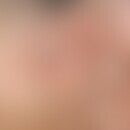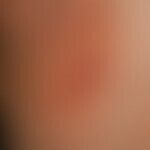Synonym(s)
HistoryThis section has been translated automatically.
Hebra, 1860
DefinitionThis section has been translated automatically.
Variant of the Tinea corporis with seat in the inguinal area.
You might also be interested in
PathogenThis section has been translated automatically.
Mostly T. rubrum, T. mentagrophytes and rarely E. floccosum.
Occurrence/EpidemiologyThis section has been translated automatically.
EtiopathogenesisThis section has been translated automatically.
Direct or indirect transmission from person to person, autoinoculation with simultaneous tinea pedum.
ManifestationThis section has been translated automatically.
LocalizationThis section has been translated automatically.
Clinical featuresThis section has been translated automatically.
S.a. Tinea corporis and Tinea intertriginosa. Sharply limited, usually marginal, scaly and itchy red plaques with little to moderate coarse lamellar scaling.
DiagnosisThis section has been translated automatically.
Detection of fungi in native preparation and culture, see also mycoses. In case of doubt also histological or molecular biological detection.
Differential diagnosisThis section has been translated automatically.
Erythrasma: No edge emphasis on the herd. Only slight itching. Brick red fluorescence in wood light
Intertrigo: Mycological diagnosis neg. bright red, usually sharply defined (satellite foci indicate intertriginous candidiasis or contact allergic eczema), extensive, itchy or painful erosions, spots or erosive plaques and often also rhagade formation in the body folds. An unpleasant sweetish foetus indicates a bacterial superinfection.
Psoriasis inversa: sharply defined, frequently itchy, usually macerated, red, fully filled 5.0 - 10.0 cm large or larger, patches or very flat sometimes weeping plaques; no prominent edge accentuation (DD Tinea intertriginosa); no satellite foci (as in candidiasis), no central healing pattern.
Intertriginous candidiasis: macerative dermatitis, typical satellite foci.
Pemphigus chronicus benignus familiaris Initial solitary or grouped, elongated vesicles or blisters, marked itching or burning. Due to confluence formation of itchy, reddened, roundish, oval or circulatory plaques covered by greasy scaly crusts, usually sharply defined, with typical transverse fissures. Often secondary infections (e.g. with Candida). Nikolski Phenomenon I and Nikolski Phenomenon II are positive.
TherapyThis section has been translated automatically.
External antimycotic therapy. S.u. Tinea.
LiteratureThis section has been translated automatically.
- Seebacher C et al (2007) Tinea of the free skin. J Dtsch Dermatol Ges 11: 921-926
- Nenoff P et al (2014) Mycology - An Update Part 2: Dermatomycoses: Clinical picture and diagnostics. YYG 12: 749-778
Incoming links (13)
Adiposity skin changes; Eccema marginatum (hebra); Epidermophytia inguinalis; Epidermophyton floccosum; Erythrasma; Intertriginous ringworm; Jockey itch; Microsporum canis; Mycoses; Pemphigus chronicus benignus familiaris; ... Show allOutgoing links (15)
Antimycotics; Candidosis intertriginous; Epidermophyton floccosum; Erythrasma; Hebra, ferdinand of; Intertriginous ringworm; Intertrigo; Mycoses; Pemphigus chronicus benignus familiaris; Psoriasis (Übersicht); ... Show allDisclaimer
Please ask your physician for a reliable diagnosis. This website is only meant as a reference.









